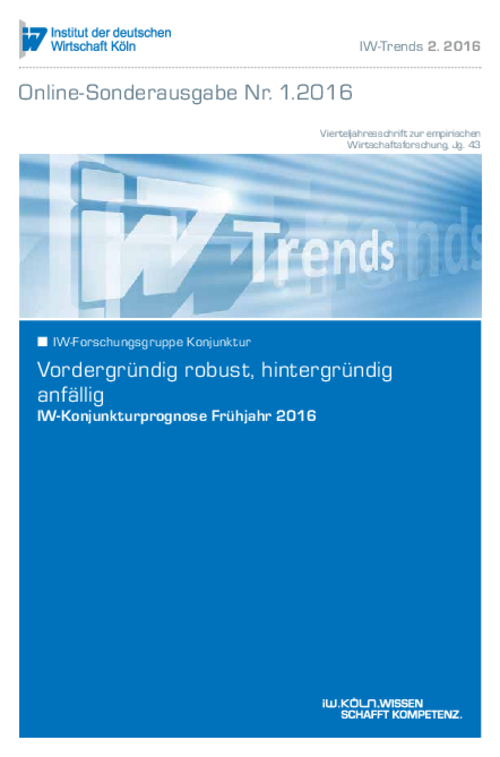IW Economic Forecast Spring 2016

Seemingly Robust, Actually Fragile
IW-Trends

IW Economic Forecast Spring 2016
Superficially the German economy appears astonishingly robust. In 2016 real GDP in Germany is expected to grow by an annual rate of 1 ½ per cent, in 2017 it will be 1 ¼ per cent. Employment will continue to rise and the national budget will stay in the black. However, this steady development is to a large extent the result of a boom in consumption encouraged by special factors: On the one hand, low energy prices and financing costs are boosting private spending. On the other hand, the German economy is being stimulated by additional public expenditure on the accommodation and integration of refugees. Without these exceptional phenomena German business activity would be on the verge of stagnation as exports are slowed by the weakness of the global economy. This is also reflected in the modest level of corporate investment. The global market for German goods and services is threatened by a multitude of stress factors. Far from waning in the aftermath of the crisis in the world’s financial markets these risks have actually grown in scope. Such an environment leaves no room for additional demands on the state.

IW-Forschungsgruppe Konjunktur: Vordergründig robust, hintergründig anfällig – IW-Konjunkturprognose Frühjahr 2016
IW-Trends

More on the topic

Effects of the Middle East conflict on the German economy
Beyond the humanitarian crisis associated with the geopolitical conflict in Israel, which affects millions of human lives, the Middle East conflict also leaves lasting marks on economic activity not only in the affected region, but also in Germany and the ...
IW
Corporate Insolvencies on the Increase
After a prolonged decline, the number of corporate insolvencies has begun to rise again. The slight increase in 2022 could be interpreted as a step towards normalisation after the sharp drop experienced during the 2020/21 Covid19 pandemic.
IW